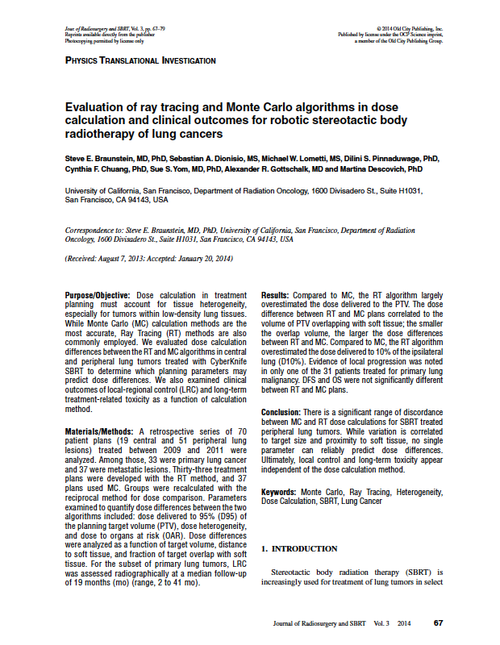- Home
- Journal Contents Downloads
- JRSBRT Downloads
- JRSBRT 3.1, p. 67-79
Product Description
Evaluation of ray tracing and Monte Carlo algorithms in dose calculation and clinical outcomes for robotic stereotactic body radiotherapy of lung cancers
Steve E. Braunstein, Sebastian A. Dionisio, Michael W. Lometti, Dilini S. Pinnaduwage, Cynthia F. Chuang, Sue S. Yom, ALexander R. Gottschalk and Martina Descovich
Purpose/Objective: Dose calculation in treatment planning must account for tissue heterogeneity, especially for tumors within low-density lung tissues. While Monte Carlo (MC) calculation methods are the most accurate, Ray Tracing (RT) methods are also commonly employed. We evaluated dose calculation differences between the RT and MC algorithms in central and peripheral lung tumors treated with CyberKnife SBRT to determine which planning parameters may predict dose differences. We also examined clinical outcomes of local-regional control (LRC) and long-term treatment-related toxicity as a function of calculation method.
Materials/Methods: A retrospective series of 70 patient plans (19 central and 51 peripheral lung lesions) treated between 2009 and 2011 were analyzed. Among those, 33 were primary lung cancer and 37 were metastatic lesions. Thirty-three treatment plans were developed with the RT method, and 37 plans used MC. Groups were recalculated with the reciprocal method for dose comparison. Parameters examined to quantify dose differences between the two algorithms included: dose delivered to 95% (D95) of the planning target volume (PTV), dose heterogeneity, and dose to organs at risk (OAR). Dose differences were analyzed as a function of target volume, distance to soft tissue, and fraction of target overlap with soft tissue. For the subset of primary lung tumors, LRC was assessed radiographically at a median follow-up of 19 months (mo) (range, 2 to 41 mo).
Results: Compared to MC, the RT algorithm largely overestimated the dose delivered to the PTV. The dose difference between RT and MC plans correlated to the volume of PTV overlapping with soft tissue; the smaller the overlap volume, the larger the dose differences between RT and MC. Compared to MC, the RT algorithm overestimated the dose delivered to 10% of the ipsilateral lung (D10%). Evidence of local progression was noted in only one of the 31 patients treated for primary lung malignancy. DFS and OS were not significantly different between RT and MC plans.
Conclusion: There is a significant range of discordance between MC and RT dose calculations for SBRT treated peripheral lung tumors. While variation is correlated to target size and proximity to soft tissue, no single parameter can reliably predict dose differences. Ultimately, local control and long-term toxicity appear independent of the dose calculation method.
Keywords: Monte Carlo, Ray Tracing, Heterogeneity, Dose Calculation, SBRT, Lung Cancer
After payment has been processed for your order of a digital copy (PDF) of this article, you will see a download link on your completed order page and also receive an email containing a download link. The links, which will enable you to download one copy of the article, will expire after 24 hours.
 Loading... Please wait...
Loading... Please wait...



